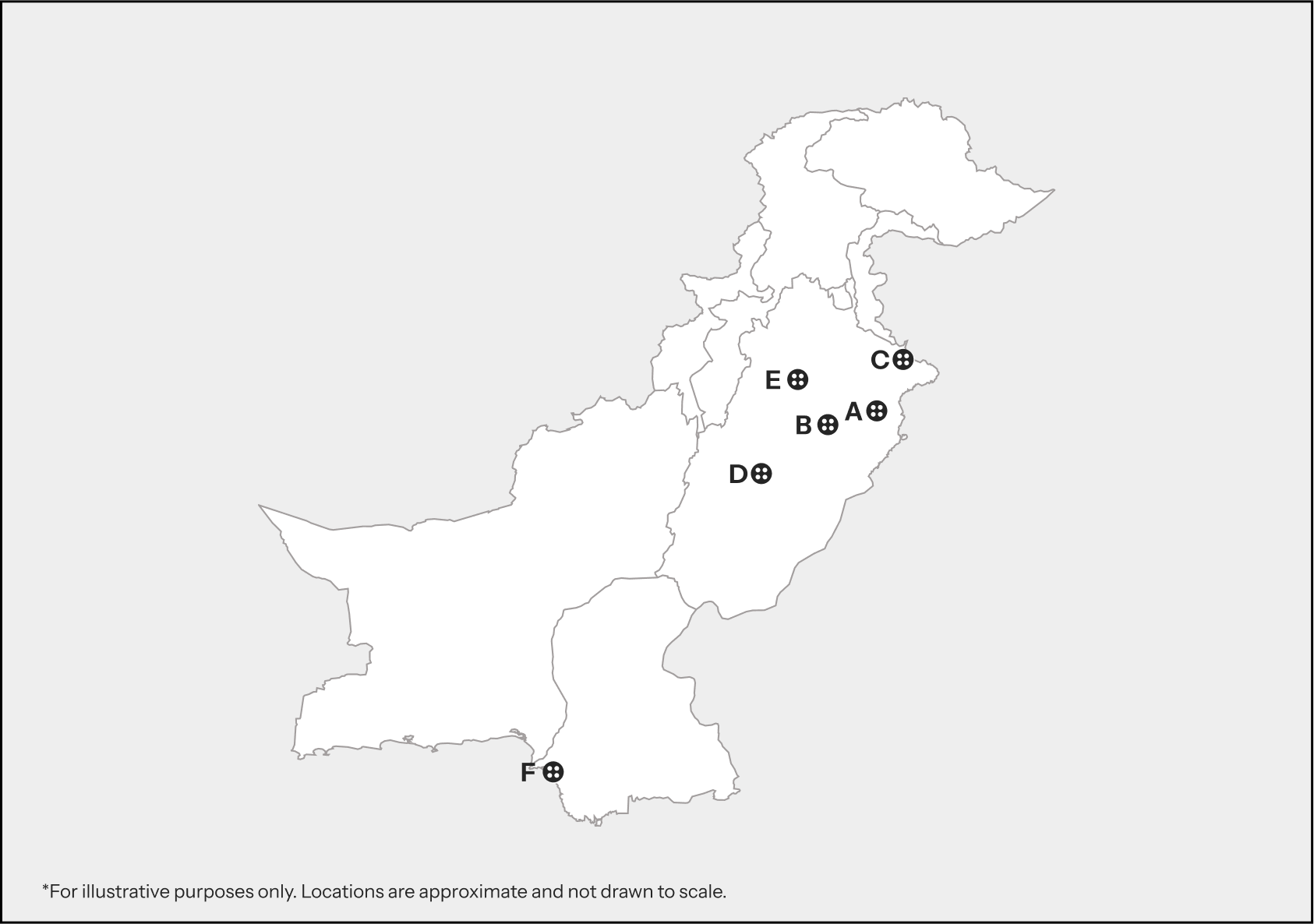*All data is in tonnes per annum
TEXTILE WASTE*
887,000
Post consumer textile waste
Cotton-rich blend (>50% cotton)
100% cotton
95% cotton (up to 5 % elastane)
Poly-cotton blends (>50% polyester)
Poly-rich blend (>50% polyester)
100% Polyester
All other blends
pre consumer textile waste
Post Industrial textile waste
887,000
Cotton-rich blend (>50% cotton)
36%
100% cotton
20%
95% cotton (up to 5 % elastane)
12%
Poly-cotton blends (>50% polyester)
9%
Poly-rich blend (>50% polyester)
11%
100% Polyester
6%
All other blends
6%
Imported textile waste
Cotton-rich blend (>50% cotton)
100% cotton
95% cotton (up to 5 % elastane)
Poly-cotton blends (>50% polyester)
Poly-rich blend (>50% polyester)
100% Polyester
All other blends
KEY POINTS ON Textiles & Apparels LANDSCAPE
$15B
Textile and Apparel Export
$3B
Textile and Apparel Imports
T&A sector contributes around 8.5% to Pakistan’s GDP, with the EU, USA, UK, and China as its key export markets. While apparel dominates exports, fibres account for the bulk of imports, with China being the largest T&A supplier. Exports are largely concentrated in low-value yarn and greige fabric, restricting growth in premium and specialized segments. Major apparel brands sourcing from Pakistan include Levi’s, Nike, and Adidas.
8.39M Bales
Cotton Production (2023–24)
Pakistan is the 5th largest cotton producer globally and ranks 6th in Asia for textile exports. Abundant cotton availability has led to a focus on cotton-rich yarn, fabric, and apparel. However, despite its historical strength, Pakistan is now a net cotton importer due to declining production. In MMF, polyester is the only major product, though the sector struggles with high import duties, making MMF-based textiles costlier and less competitive internationally.
20%
Vertically integrated mills within the textile supply chain
95% of the industry is dominated by MSMEs, while larger enterprises contribute 81% of apparel exports. Around 20% of units are vertically integrated mills, providing end-to-end capacity across the supply chain. The sector is largely domestically owned, with FDI at only 5%. Around 80% of firms operate as stand-alone manufacturers, limiting their ability to build strategic brand partnerships.
809kTon
Second-Hand Clothes Imported
Pakistan has a long-standing textile recycling culture and is a major importer of second-hand clothing, much of which is either re-exported or sold locally. However, the sector remains largely informal, resulting in inefficiencies, contamination, and poor traceability. Recycling is dominated by outdated mechanical processes focused on cotton-rich pre-consumer waste, while investment and infrastructure for advanced chemical recycling are lacking. Limited processing capacity also leads to significant downcycling of imported second-hand clothing. At the same time, Pakistan has also developed strong denim recycling initiatives converting post-consumer denim waste into new fabrics and yarns.
waste cost
waste Type
composition
price
notes
No data available
production clusters
Key regions with fibre production
Bahawalnagar(A), Rahim Yar Khan(B), Bahawalpur(C), Vehari(D), Sanghar(E)(largest cotton producing district in Sindh), Hyderabad(F), Mirpur Khas(G)

Key regions with apparel production
Lahore(A), Faisalabad(B), Sialkot(C), Multan(D), Sargodha(E), Karachi(F)

- T&A imports from China have dipped slightly since 2019 as Chinese firms established operations in China-Pakistan Economic Corridor(CPEC) - linked textile zones, shifting synthetic yarn and fabric supply from imports to local production
- Labour intensive manufacturing process is supported by a large, low-cost workforce while maintaining competitiveness in the global market
- Recycling clusters are based in Faisalabad, Lahore, Sheikhupura, Sahiwal, Jhang, Multan, Peshawar, Nankana
Waste regulation
Enforced by the Pak-EPA, it provides the legal framework for environmental protection, pollution prevention, and sustainable development. It mandates Environmental Impact Assessments (EIA) or Initial Environmental Examinations (IEE) and clearance before all new projects in public and private sectors and sets National Environmental Quality Standards (NEQS) for air, water, and noise. The Act also promotes clean technologies, resource-efficient industrial practices, and public participation to ensure transparency in environmental approvals
It aims to enhance value-added exports by strengthening the entire textile value chain while ensuring a predictable business environment. The policy highlights sustainability by encouraging efficient use of resources, reducing wastage, and supporting research in value addition and emerging technologies. It also emphasizes infrastructure upgrades such as effluent treatment and water recycling systems, laying the groundwork for greater adoption of recycled fibres and eco-friendly practices in the sector.
Waste trade
1084.88 kT
Import quantities (HS 6309, 631010)
316.32 kT
Export quantities (HS 6309, 631010)
- Faisalabad is a key hub for processing post-industrial waste
- Karachi Export Processing Zone (KEPZ) manages organized sorting, quality checks, and re-exports, and the Sher-Shah Market in Karachi functions as an informal distribution centre for domestic resale.
- The US is the largest exporter of used clothing to Pakistan. A significant portion is then re-exported to African countries
green energy
7.12%
Share of modern renewables in final energy consumption
- Renewable Electricity Generation by source: Hydro (82.7%), Wind (15%), Solar (2.2%)
- Alternative and Renewable Energy Policy 2019: It offers investors incentives such as tax breaks, lowered import duties on renewable energy equipment, and guaranteed power purchase agreements for electricity produced from renewable sources.
- Pakistan offers additional incentives, including tax holidays, full repatriation of profits, and the development of Special Economic Zones (SEZs) dedicated to renewable energy projects.
- WWF-Pakistan NAMA Support Project (Upcoming): It is a donor-funded climate initiative targeting textile and apparel SMEs to promote energy and resource efficiency, reduce CO₂ emissions, and improve productivity, with a proposed €12 million revolving fund and incentives.

